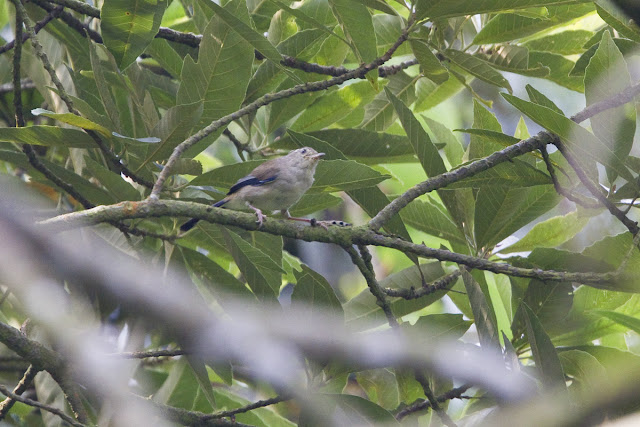I arrived at the site at around 7:15am, only one other birder was there. I scanned the area and quickly located the bird perched out in the open on some metal scaffoldings. It looks superficially like a Long-tailed Shrike when only the front can be seen, but reveals it's true identity when it turn it's back on you. The shorter and dull coloured tail and grey mantle gives it away, it's also smaller in size overall. Views were not great, as the bird remained quite far away and we didn't dare to creep any closer incase we spook the bird. The bird remained in sight for 10 minutes before being chased off by a neighbouring Long-tailed Shrike, obviously unhappy about the recent vagrant.
Grey-backed Shrike - first views of this lifer
We waited around for a bit longer as more birders arrived, all of them felt frustrated when they heard that the bird just left 30 minutes ago. David Chan also arrived later along with his friend Tom, and the wait went on and on...At the mean time, we started looking for other birds in the area. A flock of Chestnut-collard Yuhina flew-by, an extremely distant Dollarbird kept us entertained as we all tried to describe it's location to others. A few Crested Goshawk patrolled the valley constantly. Finally, another raptor dropped by in form of a Crested Serpent Eagle. I did mi-ID it as an Oriental Honey Buzzard on the day, so apologies for anyone who followed my careless mistake.
Dollardbird
Crested Goshawk
Crested Serpent Eagle
While we were well entertained by the raptors, the Shrike re-appeared finally at 10:40am. This time giving everyone a great view while calling on a telegraph pole. I first thought it was just a Long-tailed Shrike as the bird only have it's front towards us, but when it turned it's back towards us it was apparent what bird we were looking at. The bird later flew up to an overhead wire and perched for quite some time, allowing everyone to appreciate it. Feeling happy that everyone have gotten a good look, we left the scene for lunch. Here's a comparison shot of a Long-tailed Shrike for reference, taken in Long Valley on the same day.
Grey-backed Shrike - Our star of the day
Long-tailed Shrike - comparison shot
After lunch we went past Shek Kong Airfield Road, however the site was pretty quiet, where we only managed a Black-winged Cuckoo-shrike. A Pallas's Squirrel at close range kept us entertained. This is the only squirrel species we have in Hong Kong, however was likely an introduced species that have found it's niche in Hong Kong. Nothing much were spotted there and I only managed a shot of a close White Wagtail.
Pallas's Squirrel
White Wagtail (Leucopsis)
We went to Long Valley afterwards, hoping to find some buntings or bitterns. We were disappointed that we didn't find much, only a few Pallas's Grasshopper Warbler were worthy of note, but they were easily flushed and never gave any proper view. Yellow Wagtails and Siberian Stonechat's numbers have increased over the last week. Common and Pin-tailed Snipes both gave quite good views today, the Painted Snipes were again hiding at their usual pond but remained very elusive.
Common Snipe
Pin-tailed Snipe
Wood Sandpiper
Little Ringed Plover
Finally, an Asian Brown Flycatcher near Ho Sheung Heung to end our day.
Asian Brown Flycatcher









































